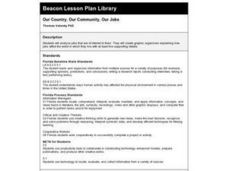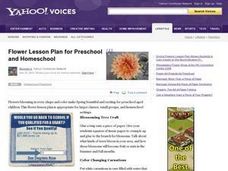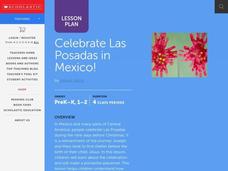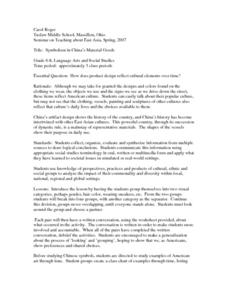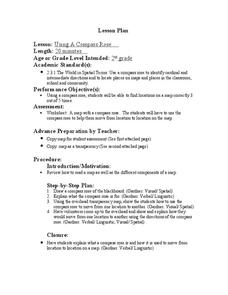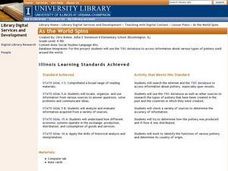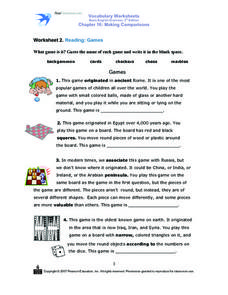Curated OER
NGA Kids Inside Scoop Summer 2007
Students examine the art of Roy Lichtenstein. In this art lesson students study reworked images and adapted scenes from books made into movies.
Curated OER
Dogfighting and the Community
Young scholars discover the threats to dogs by investigating dogfighting. In this animal cruelty activity, students read the state laws pertaining to animal safety and dogfighting. Young scholars compile dogfighting facts into a poster...
Curated OER
What Would Monet Do With a Digital Camera?
Students use a Photoshop Elements program to edit digital pictures in the style of Impressionist art. They are are introduced to paintings by Claude Monet and identify the key characteristics of the Impressionist period. Students create,...
Curated OER
Granary Door Dogon, Mali
Students explore a creation myth. In this visual arts instructional activity, students discuss the Dogon creation myth and the design and make refrigerator magnets in the style of Dogan granary doors. The design of the magnets should...
Curated OER
Our Country, Our Community, Our Jobs
Fifth graders analyze jobs that are of interest to them. They create graphic organizers explaining how jobs affect the world in which they live with at least five supporting details. They, in groups, make presentations to the class.
Curated OER
Flowers
Students create a crayon resist flower following a dicussion about Georgia O'Keefe's art.
Smithsonian Institution
The Proper Gentlemen: George Washington and "The Rules of Civility"
Students read and interpret a portion of the "Rules of Civility." They describe the significance of these rules in Washington's time. They discuss how the rules might be significant in today's world. They write rules of etiquette that...
Curated OER
Celebrate La Posada in Mexico!
Students locate and identify Mexico on a world map. They develop an understanding of celebrating La Posada in Mexico as they listen to a story about the tradition of La Posada. They create a representation of a pointsettia. They act out...
Curated OER
Worksheet 2: Games
In this games worksheet, students read four descriptions of different indoor games of the world. Students guess the name of each game and write it in the space after the description. There is a word bank.
Curated OER
Protest Signs
Students make their own chalk art or poster that represents a protest sign. In this protest sign lesson plan, students look at signs from the Civil Rights movement and then make their own.
Curated OER
Bound for Britain
Students discover the great immigration to the United Kingdom by examining historic photographs. For this world history lesson, students research the migration of West Indians to England in the early 1950's. Students read transcripts...
Curated OER
Approaching Walden
Eleventh graders examine their natural surroundings as a way to begin thinking about an abstract idea. They analyze and compare or contrast the rhetorical stategies of two essayists. Students interpret and evaluate images culled from...
Curated OER
Symbolism in China's Material Goods
Students make a generalization about the process of 'looking' and 'grouping', hoping to show that we, as Americans, show preferences and shared choices. They study examples of American art through time and create a class chart...
Curated OER
Daniel's Story Study Guide
Students explore the plight of Jews during the Holocaust. In this World War II lesson, students read Daniel's Story by Carol Matas and complete the provided comprehension, characterization, and vocabulary activities.
Curated OER
Using a Compass Rose
Second graders practice navigating around their neighborhood by utilizing a compass. In this geography lesson plan, 2nd graders view a compass rose, discover the purpose of it, and utilize it to navigate through a printed map of their...
Curated OER
Art and Anatomy: The Vitruvian Teen
Twelfth graders create an artistic version of a Vetruvian teen. For this anatomy lesson, 12th graders design an experiment to test the theory of the ideally proportioned man. They present their findings in class.
Curated OER
Falling Into Geometry Through Paper Art
Students explore geometric shapes. In this kindergarten geometry lesson, students create a fall quilt consisting of three different paper geometric quilt squares that when assembled form a scarecrow, a pumpkin, and a crow.
Curated OER
All Around the Neighborhood - Part 3
Second graders illustrate the roles, responsibilities, and skills of community members and write a paragraph that summarizes the importance of those roles, responsibilities, and skills. They are asked: "What is a role?" Students are...
Curated OER
Children's Literature Across the Curriculum Ideas-Two Eyes, A Nose, and A Mouth
Young scholars read Two Eyes, A Nose, and A Mouth by Roberta Grobel Intrater. They complete a variety of cross-curricular activities surrounding faces and facial features. Included are reading, art, math, science, writing, social...
Curated OER
Influence of Beauty, The Beauty of Influence
Tenth graders explore the influence of art on modern societies. Through the internet, they assess paintings of advertisements for commercial products and social-political beliefs. Using spreadsheet software, the class compares and...
Curated OER
Explore Your World--Geography Takes You Places
Students examine how the world around them is constantly changing. In groups, they travel between centers in their classroom to role play the role of explorers in Washington D.C. They share their experiences with their classmates and...
Curated OER
As the World Spins
Young scholars research forms of and uses for pottery. They examine the people who created the pottery and create a presentation to exhibit their findings.
Curated OER
Philanthropy, You, And Your World Lesson 1: Characterizing Philanthropic People
Young scholars determine the meaning of philanthropy and list attributes of philanthropic people. They examine philanthropic acts of themselves and others using a song and Post-It note activity.
Curated OER
Reading: Games
In this games worksheet, students read the names of 5 common games. Students then read 5 paragraphs that describe the origin of a game. Students guess the name of each game and write it in the blank space.






